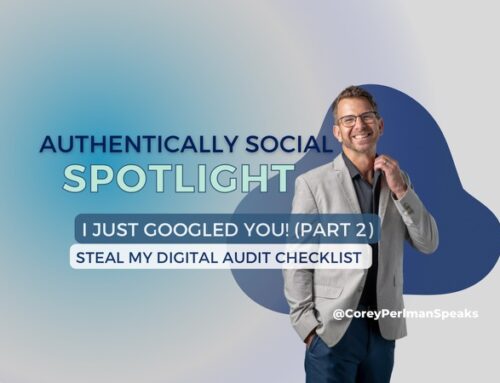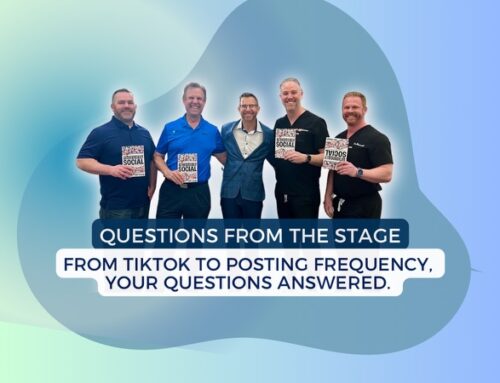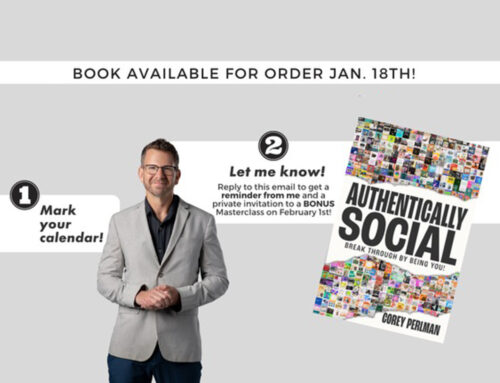eBoot Camp Update Page (3.15.10)
It’s my job! Every time I hear that Jimmy Buffett tune, it puts a smile on face because my job is helping businesses navigate the complex world of the Internet and I truly love my job. I wrote eBoot Camp in the hopes that it would give business owners, marketers, and salespeople the tools they needed to grow their business via the web.
Recently, I’ve been receiving some feedback about the book’s datedness and, subsequently, it’s accuracy. An example of this is the chapter about including Keyword meta tags for search engine placement. And this feedback is spot on. A consequence of writing a book in the technology era when rules change at the speed of…well… technology! So I wanted to provide some updates since the book was published.
I want to thank everyone who have written reviews of the book, sent me emails, and posted messages to me via Facebook and LinkedIn. Even the those who wrote to provide constructive criticism. I’ve learned from your honest words and I will use the feedback as motivation to get better.
And to the hundreds of business owners who have shared their success stories with me – I can’t tell you the joy I get out of hearing about your Internet triumphs. Keep ’em coming! From the local health club owner in Michigan who feared his computer and now checks Google Analytics as much as he checks his stock portfolio. To Angil Tarach, once intimidated by writing a blog, and has since had her words appear in the Ann Arbor News and Chicago Sun Times.
It’s the stories like that that remind me why I, indeed, love my job!
Sincerely,
Corey Perlman
Author, eBoot Camp
www.facebook.com/ebootcamp
corey@eBootCampBook.com
Keyword Meta Tags
Description Tags
Link Popularity
Duplicate Content
Other Updates
Keyword Meta Tags:
Keywords – In the original book, I recommended you spend time creating a list of keywords that reside on the backend of your Web site. These were intended to help search engines understand what your Web site was about. As marketers caught on to this, some added words on the backend that didn’t really relate to their site. To counteract this, Google has publicly said they do not look at your Keyword meta tags anymore. Here’s a link where Matt Cutts from Google explains this in greater detail:
http://googlewebmastercentral.blogspot.com/2009/09/google-does-not-use-keywords-meta-tag.html
So should you still have meta keywords on the backend of your site? I say yes. Not all search engines have made such a public stance and even Google has left the door open that they may one day evaluate them again.
Should you spend a ton of time on them? NO
Just have a list of 10 or 12 phrases up there and leave it at that.
You should be more concerned with having keywords in your website content, anchor text, image text, title tag and so on. So there’s still lots to do! I wrote a new chapter on keywords helping you decide the keywords that work best for you. You can see that below!
Keywords
The most important list you’ll ever make.
In this chapter, you will learn:
The definition of keywords.
Their importance in winning the search engine game.
The exact steps to create your critical keyword phrases .
Keywords are the words or phrases that people type in the search field when using a search engine. Your goal is to match what they type in the search engine with any words you publish on the Internet. I discuss adding keywords to the front end of your web site in the upcoming chapter, Home Page Content. In this chapter, I’ll cover how you determine what keywords you should focus on. I like to use the acronym BETA to remember the steps for coming up with your critical keyword phrases. B is for the brainstorming phase, E is for the evaluation stage, T stands for Testing and A stands for Apply!. When you complete the BETA process, you’ll end up with about 3-5 critical keyword phrases that you’ll tape to the front of your computer screen and use whenever you are publishing content online.
The brainstorming phase is similar to many green-like thinking sessions you’ve had where no answer is a wrong answer. This is also the phase where you want to solicit as much help as you can. The goal of this stage is to figure out what people are searching in Google and the other engines to find sites like yours. Notice I said “like yours” – that’s because you don’t want to focus on the people who are actually looking for your exact site. Why? Well, they are already looking for you. Yes, you want to show up #1 on Google when someone types your name in, but even if you show up further down the page, they’ll scroll and most likely find your site. It’s when people do a search on Google and don’t care who they find, that you want to show up in the top 3 results. These are more generic words or phrases about the products or services that you sell. The best way to come up with these words or phrases is to ask people who know nothing about your business. In fact, you will do this in an exercise later in this chapter. At the end, you’ll have a long list of words that a person would use when looking for your product or service on a search engine. You should include cities in which you do business, product and service names, and other common words used to describe your business.
Once you have this long list, it’s time for the Evaluation stage. In this stage, you go out to Google and put some of these phrases in and see who’s getting the top three rankings. You can garner a lot of information from this exercise. You can see key details of these top performing sites such as the title tags and description tags, (both of which are discussed in detail in upcoming chapters), the Website content and where the phrases are being used and lots more. You can also see how many sponsored ads show up on Google’s results page to get a feeling for how competitive the phrase is. If you see lots of ads, that means there’s probably lots of traffic searching for these terms and conversely, if the sponsored ads area looks like a ghost town, then it’s probably not a highly competitive phrase. These results allow you to survey the landscape and just see what you’re up against if you decide to spend time competing for these phrases.
Ok, so now you’ve done some evaluating, and you have a few phrases that you THINK would result in some quality leads if you started ranking in one of the top 3 positions on Google. The problem with this is the word Think – this word has gotten a lot of in trouble over the years and wasted all sorts of time. Optimizing for keyword phrases (that just means using certain phrases throughout the content you publish on the web) takes time – sometimes months, sometimes years and the last thing you want to do is spend all that time only to find out you were wrong and only a handful of people are actually searching that phrase. Well, this won’t happen to you because you will take your potential keyword phrases through the Testing phase – which is the T in our BETA acronym. There are lots of cool keyword tools out there that will actually tell you how many people are searching for these phrases. Google has their own keyword tool and you can find that tool by searching “keyword suggestion tool” in the google search bar. Wordtracker.com is a popular keyword tool that gives you data on all of the top search engines. They are a pay-for service, but well worth the small fee. So you’ll put your phrases in to one of these tools and find out just how many people are actually searching for this phrase and other similar phrases as well. Obviously, the more popular the phrase, the tougher it will be to earn a top ranking. So you shouldn’t go for the super popular and you should go for the super unpopular. Find phrases that get a satisfactory amount of traffic and start there. I can’t give you an exact num
ber because I don’t know your business or your industry, but think middle of the road and you should be ok.
Once you’ve gone through the Brainstorming phase, the Evaluation phase and the testing phase, it’s time to Apply! As mentioned earlier, I want you to write these phrases on a sticky-note and slap them somewhere very noticeable on your computer. When you write a blog post, use those phrases, an article, use those phrases, some new website content, you better use those phrases. The bottom line: any time you write something online that is visible to the public, at least be thinking of these phrases and how you can use them in your copy. Just remember, don’t overdue it. Concentrate on quality content and only put these phrases in when appropriate. Never try to fool the search engines by placing phrases on pages over and over again. That’s called keyword stuffing and is frowned upon by the engines. Plus, it will annoy your readers – so don’t do it!
The most important thing to do when creating a powerful keyword list is to forget everything you know about your business. Instead, think like a complete stranger who’s sitting at his computer early in the morning, sipping a cup of coffee, and just landed on Google. He’s about to buy a product you own or use a service you provide. He doesn’t care if he buys it from you or from one of your competitors; he just wants to find a business that has what he’s looking for and be on his way. What words is he going to type in Google? Answer that question, and you’re well on your way to creating a powerful keyword list!
Tips for Success
No. 1. As you probably already know, Google has publicly said they are no longer looking at your meta keywords (a keyword list that resides in the html code of your Website) when determining where to rank your website in their engine. I still suggest including a keyword list, however, on your Website. Why? Well, other search engines still may evaluate them, Google could change their mind, and it’s a great place for words that you wouldn’t want to put on your homepage. An example of this might be misspelled words that are related to your business or variations of a state like Cali, CA, or CAL.
No. 2. Keywords can also be key phrases. For example, instead of ” house ” or ” Michigan, ” use phrases such as ” houses in Michigan, ” ” Michigan real estate, ” and so on. In most cases, the longer the phrase, the better chance you have of ranking high for that phrase. A long phrase (often called a long tail keyword) can get you very targeted traffic with a high conversion rate.
No. 3. Do not repeat keywords. You can use words in phrases more than once but not independently. For example, the right way is ” car phone, ” ” car door, ” and ” car window. ” The wrong way would be ” car, ” car, ” and ” car. “
Walkthrough
Step 1. Open up Internet Explorer.
Step 2. Go to google.com.
Step 3. Type in the words “keyword suggestion tool” and click on Google’s Keyword tool.
Step 4. Keep the descriptive words box checked and type in one of your critical keyword phrases.
Step 5. Click ‘get keyword ideas’
Step 6. The first column, titled local search volume, tells you how many searches occurred for that phrase last month. The 2nd column, Global monthly search, tells you how many searches occurred on average over the past 12 months. A seasonal keyword phrase like Christmas gifts would probably have a much higher volume in October and November than the rest of the months.
Step 7. Evaluate your results and also look at the other synonyms they provide. Take note of the minor differences in each word and the impact it has on search volume. For example, look at a word and its plural and take notice of the difference.
Exercise Author’s note: This exercise is very important and requires a good deal of time and attention. I recommend that you spend an entire afternoon or evening on it, and include others (spouse, colleague, friend) in the brainstorming process. Keep an open mind and have fun with the process. On Friday nights, my wife and I will often invite other couples over, open a few bottles of wine, and exchange keyword ideas. A good ol’ fashioned nerds night out!
Step 1. Start thinking about your business, the services or products you provide, and how you help people.
Step 2. Write down 30 words or phrases that describe your business:
Step 3. Write down the 30 words or phrases that your spouse, colleagues, and friends chose to describe your business:
Step 4. Now close your eyes and put yourself in the shoes of a potential customer who has no idea who you are or what you do. All this person knows is that he or she needs a
service or product that your web site provides. Remember, you are now in the mind of a potential customer. Write down the first 10 phrases that come to mind:
Step 5. Take the three lists and prioritize them into one list of 20 words or phrases. Remember to localize your list by including cities and counties you do business in.
Step 6: Now test those phrases in a keyword suggestion tool and narrow them down to about three.
Congratulations! You have just created your critical keyword phrases for your web site. Case Study
Description Tag
Similar to meta keywords, Google has also publicly stated they do not look for keywords in your Description tag. Here’s their formal explanation of how they use Description tags:
“…we do sometimes use the “description” meta tag as the text for our search results snippets
Even though we sometimes use the description meta tag for the snippets we show, we still don’t use the description meta tag in our ranking.”
So what does this mean? Well, it’s still a critical sentence to work on and have on the backend of your site. Remember, this is the black text under the blue link when your Web site shows up on Google or the other search engines. I’d rather give Google something to use than leave it up to them to pick something off of my site. Although they say they “sometimes” use the description, I find it to be almost always. So make it count!
Duplicate Content
Google and the other search engines are trying to give users fresh, relevant content based on their search query. What Google does not want to do is give searchers a bunch of results that are the exact same thing. Hence their issue with Duplicate Content. Many a business owner and marketer worry that Google or the other search engines will penalize them if they have some content that appears in more than one place. That’s not the case at all. Google understands that content such as press releases get distributed all over the web and so they know there might be multiple versions on the Web. They are more concerned about duplicate Web sites or blogs that are literally mirror images of each other and are being used to try and trick the search engines. So, as with most search engine rules, as long as you aren’t deliberately trying to deceive the search engines, you should be ok.
For Google’s official stance on Duplicate Content, go to:
http://www.google.com/support/webmasters/bin/answer.py?hl=en&answer=66359
Link Popularity
As a reminder, when I refer to Link Popularity, I mean how many other Web sites have a link that directs people to your site. Google and the other search engines use link popularity as a part of their overall ranking algorithm. In my book, I refer to doing a link-exchange where you and another businesses help each other out by each adding a link to each other’s site. The example I often use is asking your local chamber to include a link to your site and you add a button that proudly displays the chamber logo and link back to theirs.
What I should have clarified is that it is better to have a one-way link than a reciprocal link. Search engines kn
ow that any site can simply do a link-exchange, but sites that simply add your link to theirs without a return favor would seem to be more legitimate. So, to be clear, it’s perfectly ok to have some reciprocal relationships (like the chamber example) but strive to have relevant, quality websites link to content you have on your site.
Other Updates:
* As mentioned above, you can also use keyword phrases in places like anchor text (ex: I have an Internet Marketing Book), image alt text, and URL structure (ex: ebootcampbook.com/seo-tips-strategies)
* Remember that Google tries to look at your site as a person would. So if you have big, bold text on the page that stands out, they will look at that a bit more closely than the regular text. Those are called header tags.
EX: Search Engine Marketing Made Easy
* Understand that you can tell search engines parts of your site that you DON’T want them to evaluate. An example of this would be your 404 page (see www.ebootcampbook.com/404) Your web designer can do this by creating a robots.txt file.
* I’m in the process of migrating my blogger blog (www.coreyperlman.com) to reside inside of my regular Web site (www.ebootcampbook.com). I want to have everything under one umbrella so I’m not constantly having to work on two separate sites for better Google rankings. So there will be a blog link on my Web site and it will just send people to the blog page within my site.






